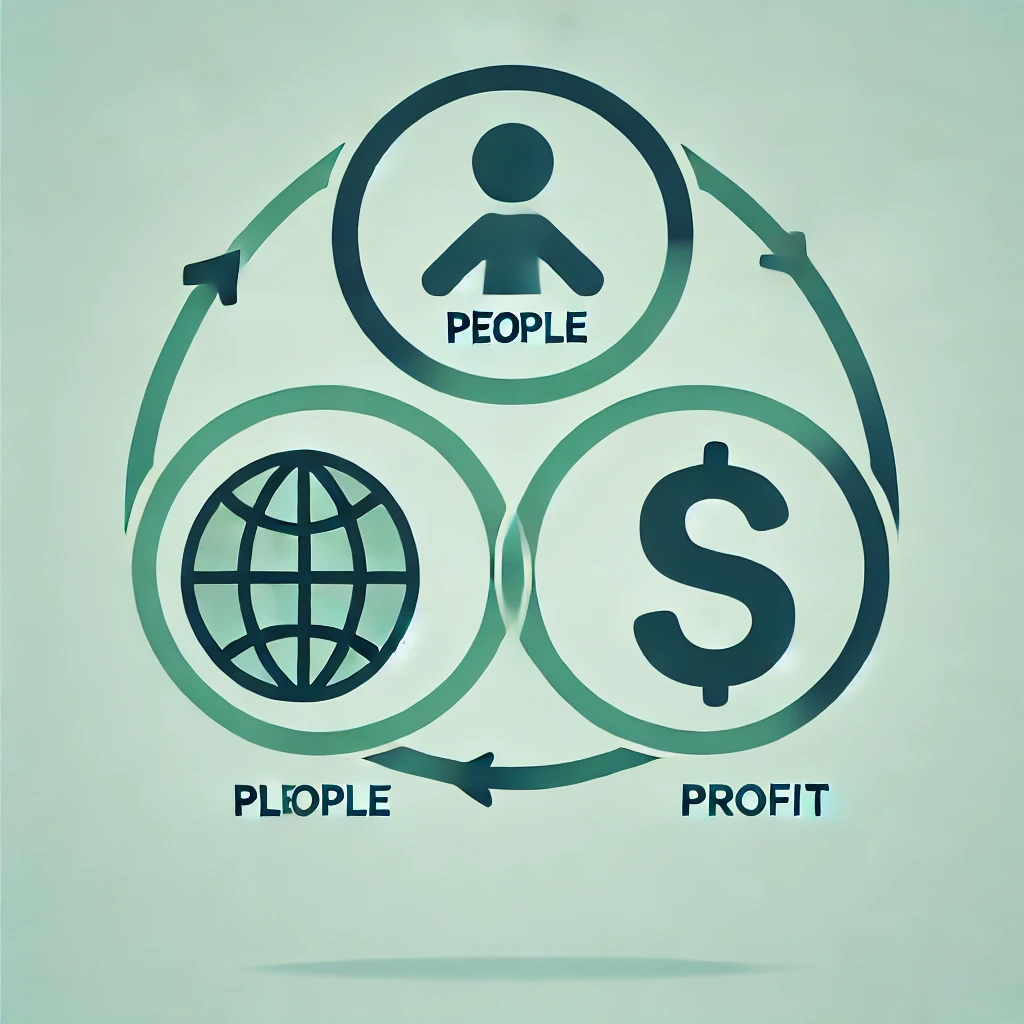
In today’s fast-paced and ever-evolving business landscape, sustainability has become a key focus for companies striving not only for profit but also for positive societal and environmental impact. A framework that encapsulates this holistic approach to business is known as the Triple Bottom Line (TBL). Unlike traditional business models that prioritize financial profit alone, TBL emphasizes a balance between three critical components: People, Planet, and Profit.
The Triple Bottom Line is a concept introduced by John Elkington in 1994, which advocates for a more comprehensive evaluation of a company’s success. Traditionally, businesses have measured their performance based solely on financial outcomes. However, TBL expands this evaluation to include social and environmental dimensions alongside profit.
-
People: This aspect focuses on the social responsibility of a company, emphasizing its impact on employees, customers, communities, and other stakeholders. It involves ensuring fair labor practices, promoting diversity and inclusion, contributing to community development, and creating a positive work environment. Essentially, it's about the company’s efforts to "give back" to society.
-
Planet: Environmental sustainability forms the second component of TBL. It involves practices that minimize the ecological footprint, such as reducing waste, conserving energy and water, sustainable sourcing, and investing in renewable energy. Companies adopting TBL strive to operate in an eco-friendly manner, acknowledging their role in combating environmental issues like climate change and resource depletion.
-
Profit: While profit remains crucial, under the TBL model, it is not achieved at the expense of social welfare or environmental health. Instead, profit is pursued alongside efforts to create positive social and environmental outcomes. Companies operating under TBL aim to build long-term financial success through sustainable and ethical practices.
The TBL framework is more relevant today than ever before, as consumers, investors, and employees increasingly demand that companies act responsibly. Here’s why TBL is gaining traction:
-
Enhanced Brand Reputation: Companies that practice TBL are often viewed more favorably by customers and the public. They are seen as ethical, responsible, and forward-thinking, which can translate into brand loyalty and customer trust.
-
Risk Mitigation: By addressing social and environmental risks, companies can better navigate regulatory changes, avoid environmental penalties, and reduce the likelihood of public relations crises related to unethical practices.
-
Attracting Investment: Investors are increasingly looking at a company's sustainability efforts as part of their investment decisions. Businesses that align with TBL principles often attract impact investors who are interested in funding companies that contribute to positive social and environmental change.
-
Employee Engagement: Employees, especially millennials and Gen Z, prefer to work for companies that reflect their values. TBL practices can boost employee morale, retention, and productivity, as workers are more likely to be engaged in a purpose-driven organization.
-
Long-Term Profitability: Contrary to the belief that sustainability is a cost, TBL-oriented companies often find that sustainable practices can lead to cost savings (e.g., energy efficiency), innovation (e.g., new eco-friendly products), and increased market opportunities, ultimately contributing to long-term profitability.
Many companies globally have embraced the TBL framework, showcasing how business can be conducted with a balance between profit, people, and planet:
-
Patagonia: The outdoor apparel brand has built its entire business model around environmental sustainability. From using recycled materials to donating 1% of its sales to environmental causes, Patagonia puts the planet first while maintaining financial success.
-
Unilever: Unilever integrates TBL into its Sustainable Living Plan, addressing climate change, plastic reduction, fair labor practices, and community development, all while growing its business and creating economic value.
-
City Developments Limited (CDL) in Singapore: As a leader in sustainable real estate, CDL integrates eco-friendly building practices, community engagement, and economic growth. Their approach demonstrates how TBL can drive innovation and create long-term value.
Despite its benefits, adopting the TBL approach comes with its set of challenges:
-
Measuring Impact: While financial metrics are straightforward, quantifying social and environmental impact can be complex. Companies often struggle with identifying appropriate metrics and reporting standards for non-financial performance.
-
Balancing Priorities: In practice, aligning social, environmental, and financial objectives can be difficult, as these goals may sometimes conflict. For instance, choosing more sustainable materials can increase costs, potentially impacting profitability in the short term.
-
Change Management: Transitioning to a TBL model often requires a shift in corporate culture, decision-making processes, and business strategy. This change can meet resistance within the organization and requires strong leadership to implement successfully.
For companies interested in embracing the TBL framework, here are some actionable steps:
-
Set Clear Goals: Define specific, measurable, and achievable goals for each component of TBL (social, environmental, financial). This can include targets for carbon reduction, community development, and profit margins.
-
Engage Stakeholders: Include employees, customers, suppliers, and the community in your sustainability journey. Transparent communication and stakeholder engagement are key to building a credible TBL strategy.
-
Integrate TBL into Business Strategy: Embed TBL principles into the core business strategy. Ensure that sustainability is not treated as a side project but as an integral part of the company's mission and operations.
-
Report and Reflect: Regularly monitor and report on your TBL efforts through sustainability reports. Reflect on what’s working, identify areas for improvement, and be transparent about the journey toward sustainability.
The Triple Bottom Line is more than a buzzword; it's a guiding principle for businesses aiming to make a lasting impact on society and the environment while achieving financial success. As companies navigate the complexities of today's global market, adopting TBL can lead to innovation, resilience, and a positive legacy. By focusing on people, planet, and profit, businesses can build a sustainable future that benefits everyone.
Adopting the Triple Bottom Line may present challenges, but the rewards—both ethical and financial—can be substantial. In the end, TBL offers a holistic pathway for companies to grow responsibly, drive change, and contribute to a world where business success aligns with social and environmental well-being.

 Hello 大家好!歡迎返嚟我哋嘅頻道,我哋會喺度探索實現目標同過最好生活嘅最佳提示同策略!今日,我哋會深入探討一個真係可以改變你未來嘅話題——財務安全。靈感係嚟自 Scott Galloway 嘅智慧書《財富的代數:財務安全嘅簡單公式》,我哋會拆解一個實用嘅框架,幫你邁向經濟穩定同成功。
Hello 大家好!歡迎返嚟我哋嘅頻道,我哋會喺度探索實現目標同過最好生活嘅最佳提示同策略!今日,我哋會深入探討一個真係可以改變你未來嘅話題——財務安全。靈感係嚟自 Scott Galloway 嘅智慧書《財富的代數:財務安全嘅簡單公式》,我哋會拆解一個實用嘅框架,幫你邁向經濟穩定同成功。 歡迎返嚟我哋嘅頻道!今日,想同大家講吓其中一個最強大嘅數據平台——Elastic Stack 8.0 呀。我哋嘅靈感係嚟自 Asjad Athick 寫嘅《Getting Started with Elastic Stack 8.0: Run powerful and scalable data platforms to search, observe, and secure your organization》。
歡迎返嚟我哋嘅頻道!今日,想同大家講吓其中一個最強大嘅數據平台——Elastic Stack 8.0 呀。我哋嘅靈感係嚟自 Asjad Athick 寫嘅《Getting Started with Elastic Stack 8.0: Run powerful and scalable data platforms to search, observe, and secure your organization》。
 大家好!歡迎返嚟我哋頻道。今日,我哋會深入探討一本你可能見過最全面嘅搜索技術指南——Madhusudhan Konda 嘅《Elasticsearch in Action》。呢本書唔單止係另一本技術手冊;佢係你掌握用 Elasticsearch 同 Kibana 開發可擴展同高效搜索應用嘅大門。
大家好!歡迎返嚟我哋頻道。今日,我哋會深入探討一本你可能見過最全面嘅搜索技術指南——Madhusudhan Konda 嘅《Elasticsearch in Action》。呢本書唔單止係另一本技術手冊;佢係你掌握用 Elasticsearch 同 Kibana 開發可擴展同高效搜索應用嘅大門。
 女士們先生們,歡迎返嚟我哋嘅頻道!今日,我有一個嘅話題要同大家分享——點樣建立一個充實又有意義嘅職業生涯。
女士們先生們,歡迎返嚟我哋嘅頻道!今日,我有一個嘅話題要同大家分享——點樣建立一個充實又有意義嘅職業生涯。 大家好,歡迎回到我哋嘅頻道!今日我哋要同大家深入探討一本好有趣嘅書,呢本書為我哋提供咗一種新嘅視角,講俾我哋知點樣喺呢個變化好快嘅世界中茁壯成長。呢本書嘅書名係《個人時代 - 不能只是去做 重點是你「想」點樣做!》,作者係宋吉永。英文書名可以翻譯成《The Personal Age - It's Not Just About Doing; It's About How You Want to Do It!》。相信我,真係一本好吸引嘅書。
大家好,歡迎回到我哋嘅頻道!今日我哋要同大家深入探討一本好有趣嘅書,呢本書為我哋提供咗一種新嘅視角,講俾我哋知點樣喺呢個變化好快嘅世界中茁壯成長。呢本書嘅書名係《個人時代 - 不能只是去做 重點是你「想」點樣做!》,作者係宋吉永。英文書名可以翻譯成《The Personal Age - It's Not Just About Doing; It's About How You Want to Do It!》。相信我,真係一本好吸引嘅書。